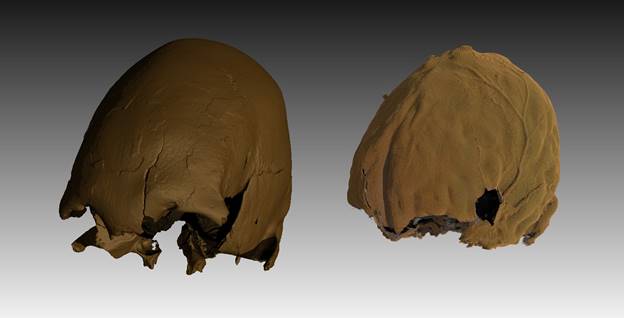11,000 Year Old Social Complexity Shown by the Oldest Known Intentionally Deformed Skull from Eurasia
An 11,200-11,400 year old fossil of an adult man’s skull from a pre-agricultural culture in northeastern China, termed Songhuajiang Man I, is the oldest record of intentional skull deformation in Eurasia, and one of the oldest records in the world. Evidence from stable isotopes in the fossil show that Songhuajiang Man relied on foods like fish from rivers and lakes. This fossil of an intentionally modified human skull from Heilongjiang Province in China is described in a new paper in the journal Archaeological and Anthropological Sciences by Chinese, American, and Pakistani authors.
In well-known societies around the world such as the ancient Mayans, Egyptians, Huns, and Polynesians, the skull was intentionally deformed into a non-natural shape by compressing an infant’s head with hand pressure, binding the head with hard and flat surfaces, or by tightly wrapping the head in cloth, Songhuajiang Man I is the oldest evidence in the world for what is called tabular deformation; where hard and flat surfaces are bound to the forehead and back of the skull of an infant in order to permanently alter their skull shape. In the resulting adult’s head, the forehead is flatter and taller with a similarly flattened back of the skull. In this Chinese fossil, the adult deformed skull preserves traces of the hard surfaces that were bound to the skull during his infancy. CT-scanning of the fossil reveals features present in intentionally deformed skulls such as permanent changes to blood vessel flow around the brain, and the growth of small bones, called wormian bones, along the edges of the major skull bones. Those features help to determine that the skull grew into its deformed shape rather than having been changed after the man’s death. This type of skull deformation is a highly recognizable and distinct feature in adults, differing from our typical rounded head shape. These changes cannot be reversed because the skull bones grow and fuse into the deformed shape. It is a life-long indicator of status.

CT-scanned image of the intentionally deformed Songhuajiang Man I skull (left) and its brain shape reconstruction (right)
Dr. Xijun Ni, the lead author on the study from the Institute of the Vertebrate Paleontology and Paleoanthropology (IVPP), Chinese Academy of Sciences, says, “Most people would probably link the ability to farm with complex societies and having a hereditary hierarchy where there are different classes of people with some socially above others. This fossil from a fishing community helps to show that hierarchy and maintaining identity and social standing across generations was a feature that arose independent from farming.”
The extreme age of this intentionally deformed fossil and its location in northeastern Asia where people emigrated to North and South America suggests that the immigrants might have carried this cultural practice of deforming infant skulls to the New World.

The oldest records of the cultural practice of intentional skull deformation around the world, and their potential links via immigration to North and South America
Co-author, Dr. Thomas Stidham of the IVPP adds, “The earliest places around 11,000 years ago with evidence of skull deformation in Iraq, Australia, and China are within 800 years of each other. This kind of skull deformation may have spread rapidly in a way similar to a social media meme today, and in this case, as a meme continuing from one generation to the next. While the practice may have started independently in those different places, we know people are always ready to click ‘like’, copy styles, and spread memes they think are cool.”
Citation: Ni, X., Q. Li, T.A. Stidham, Y. Yang, Q. Ji, C. Jin, and K. Samiullah. 2020. Earliest-known intentionally deformed human cranium from Asia. Archeological and Anthropological Sciences. https://doi.org/10.1007/s12520-020-01045-xDownload attachments: